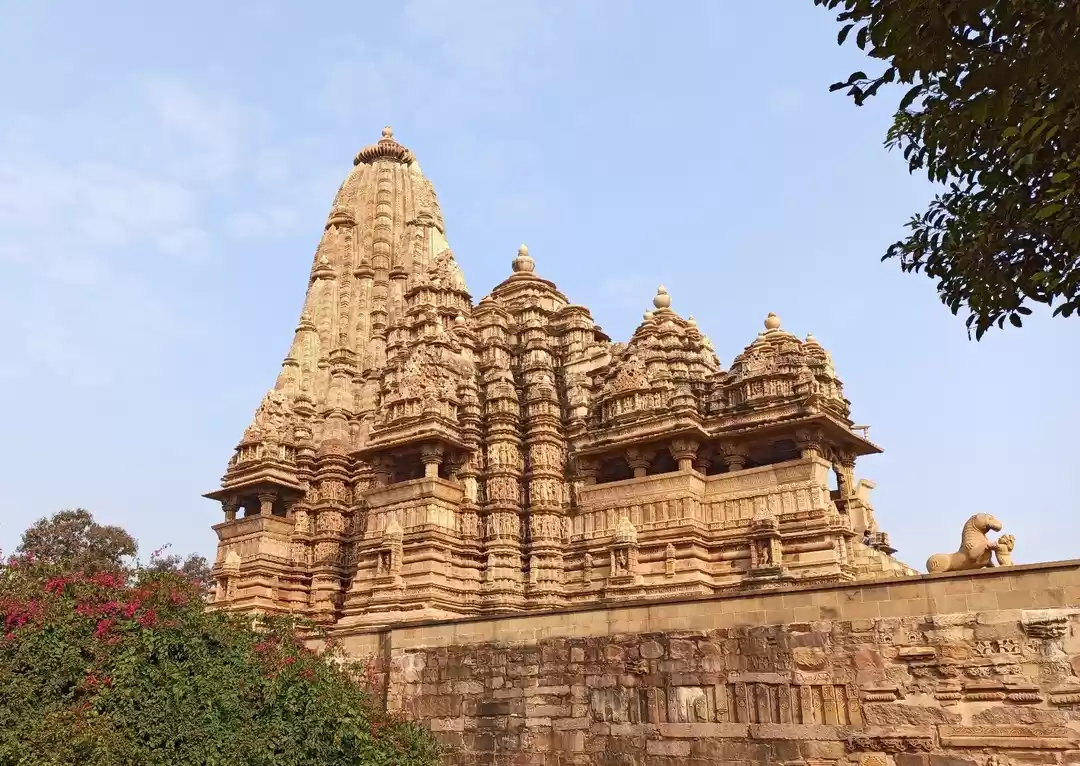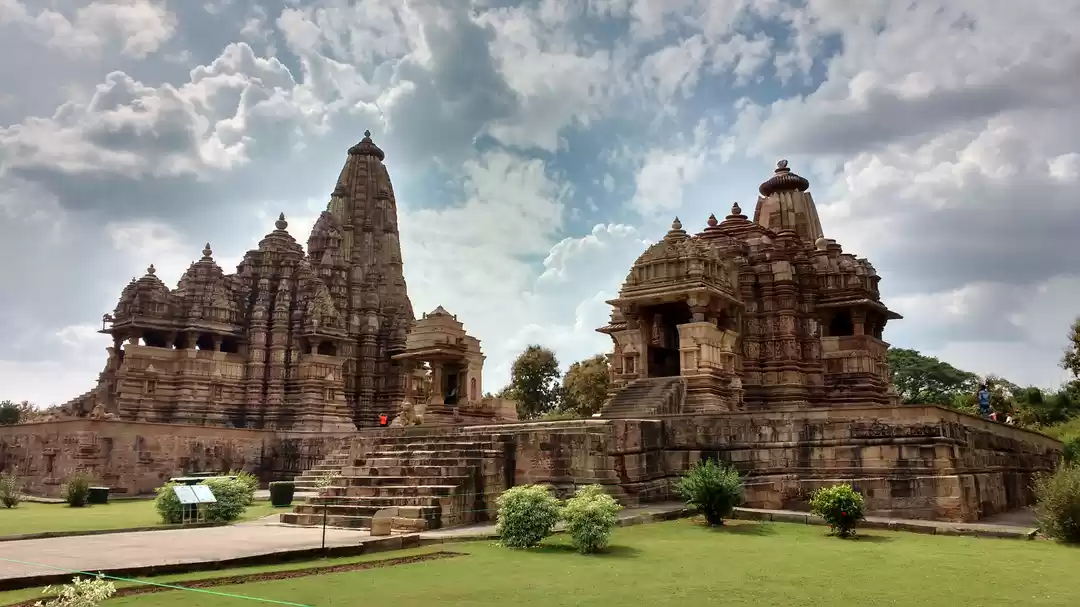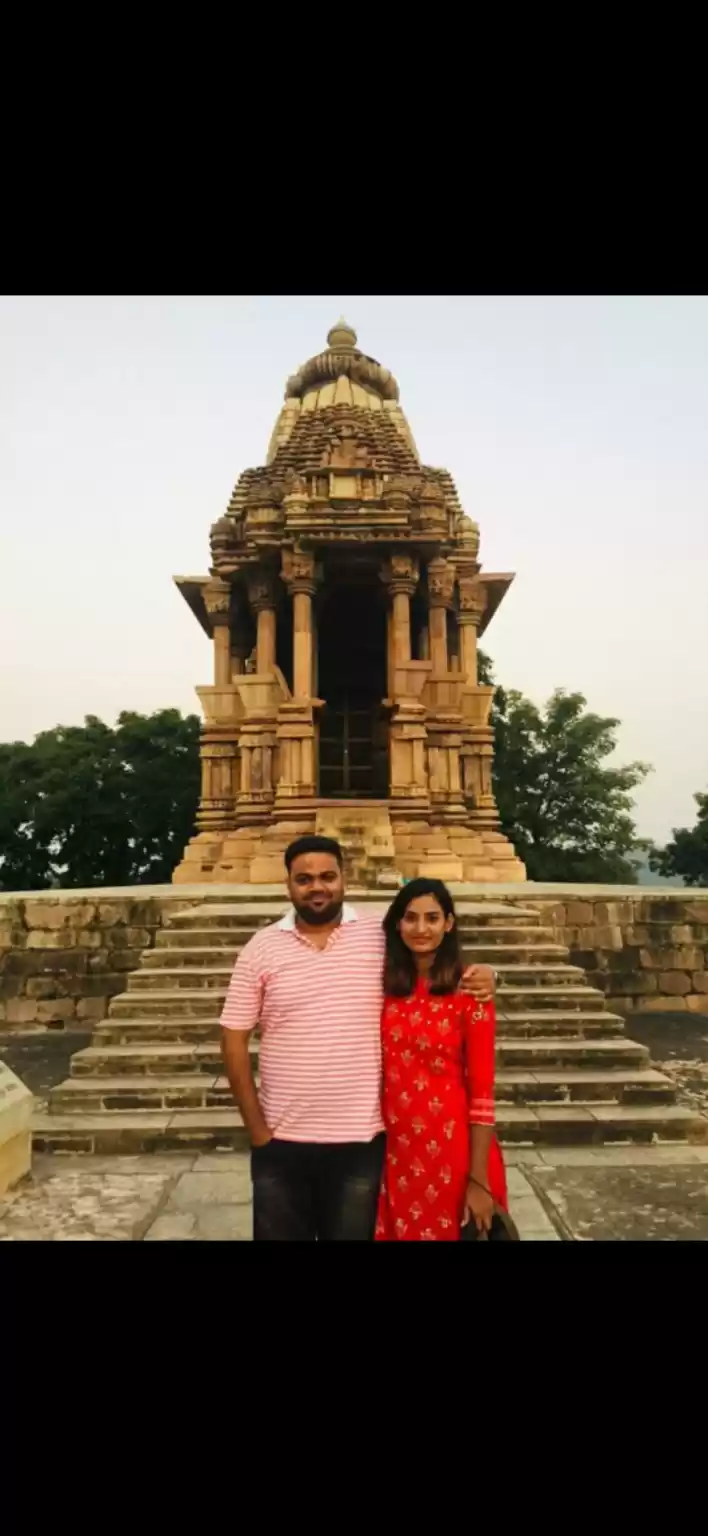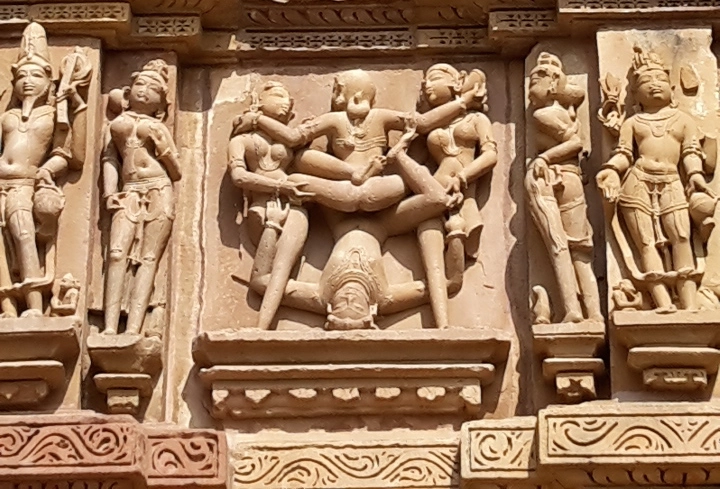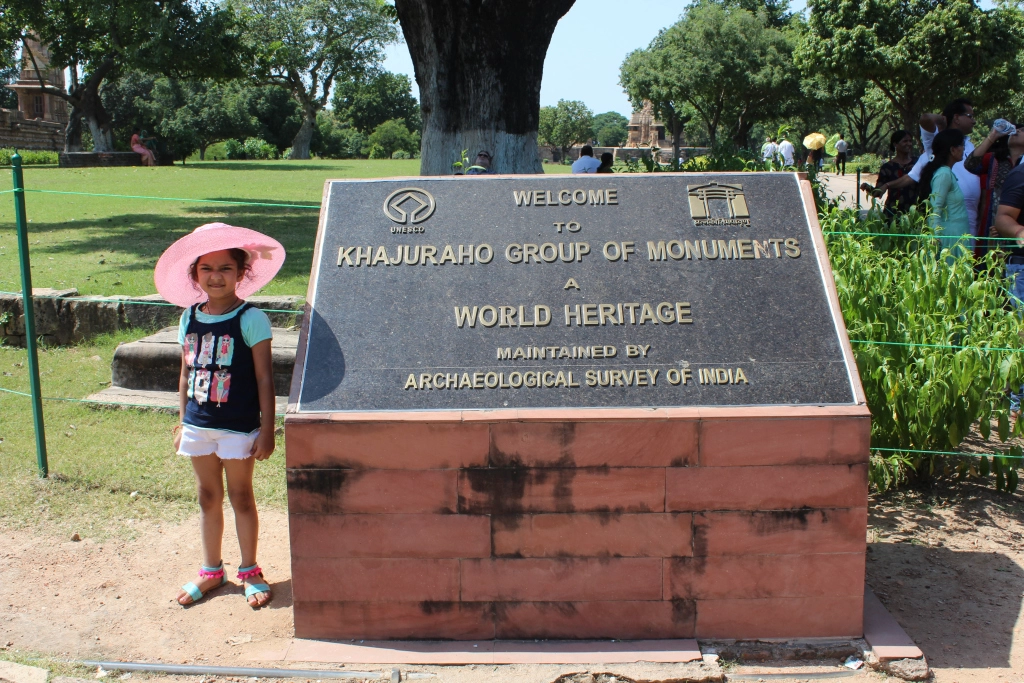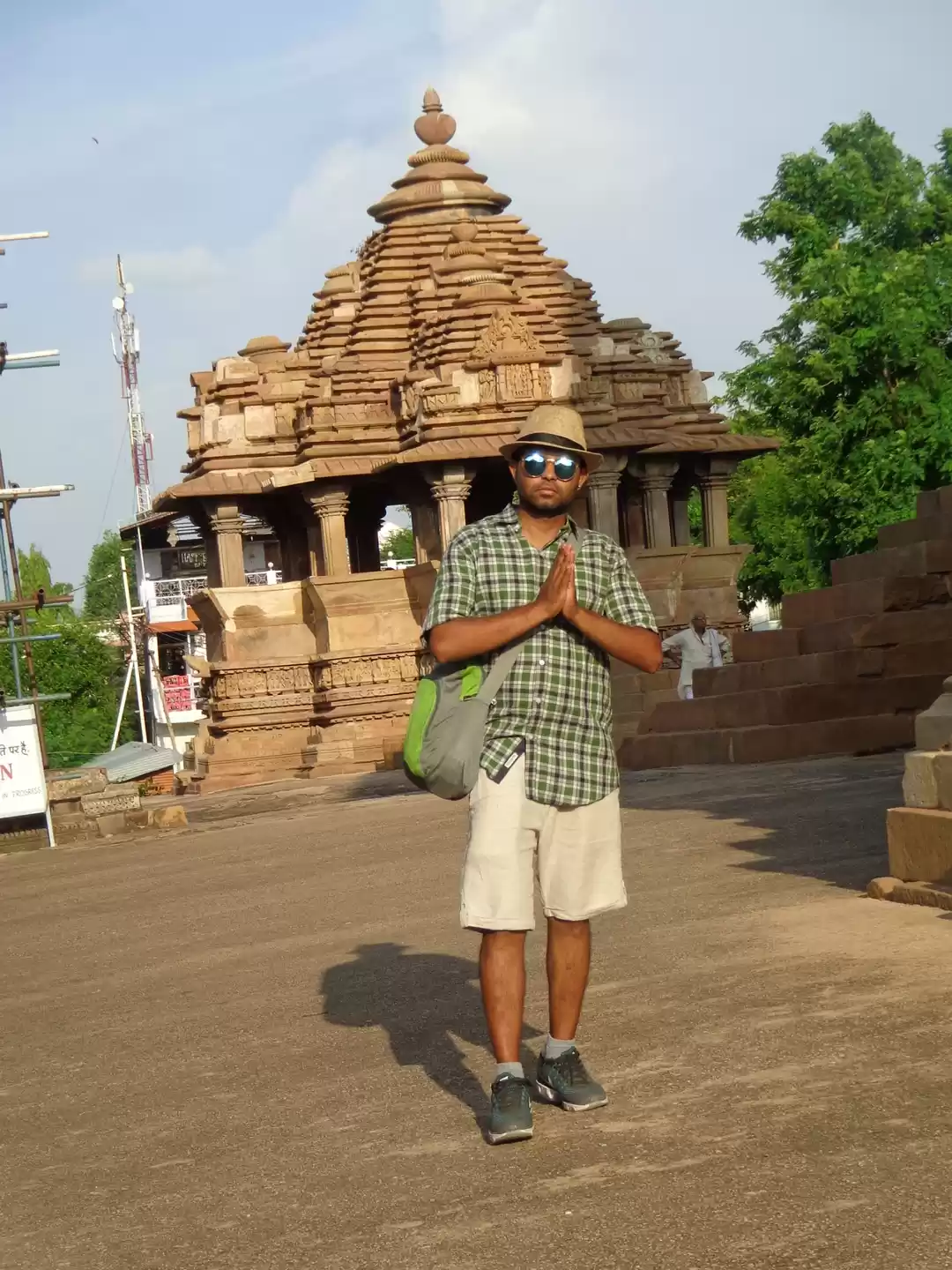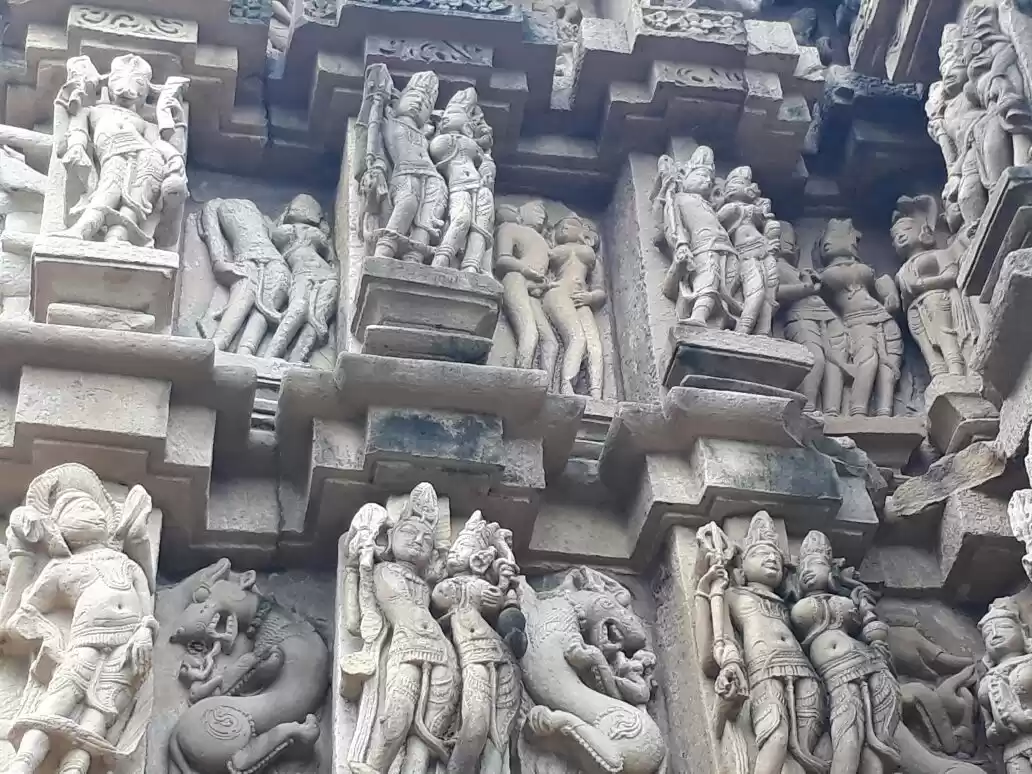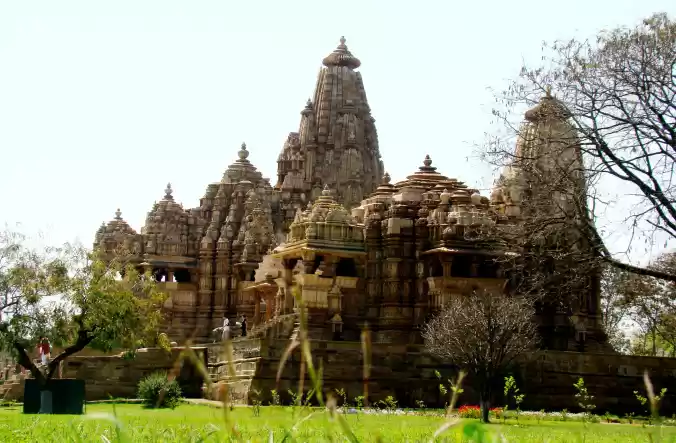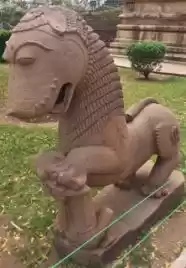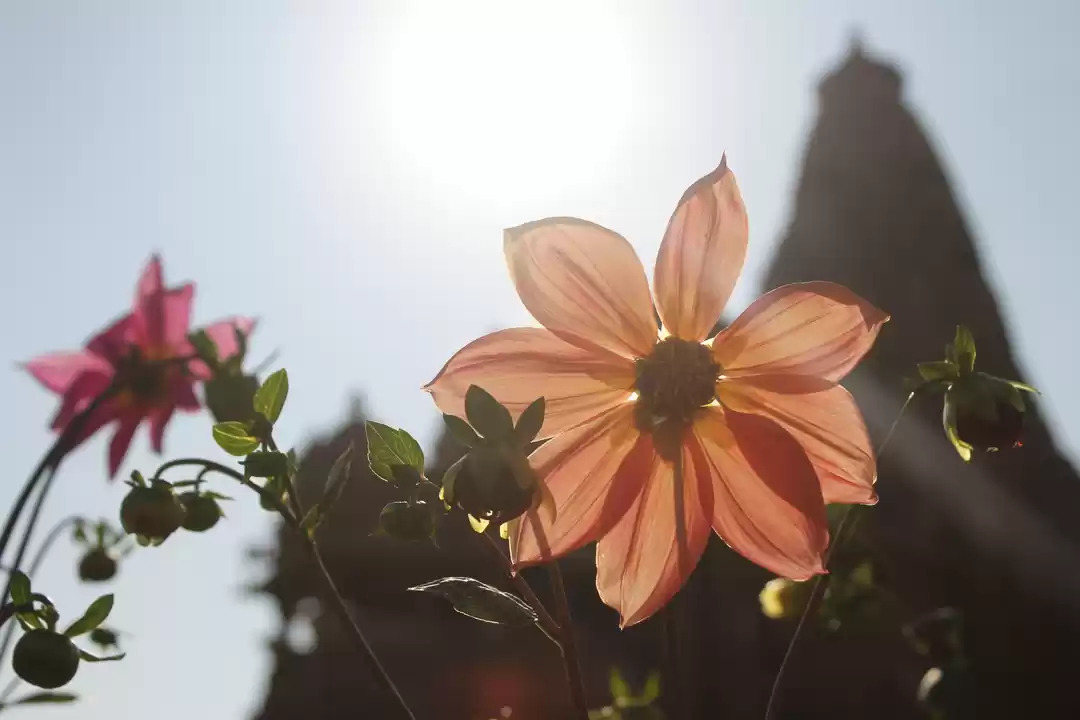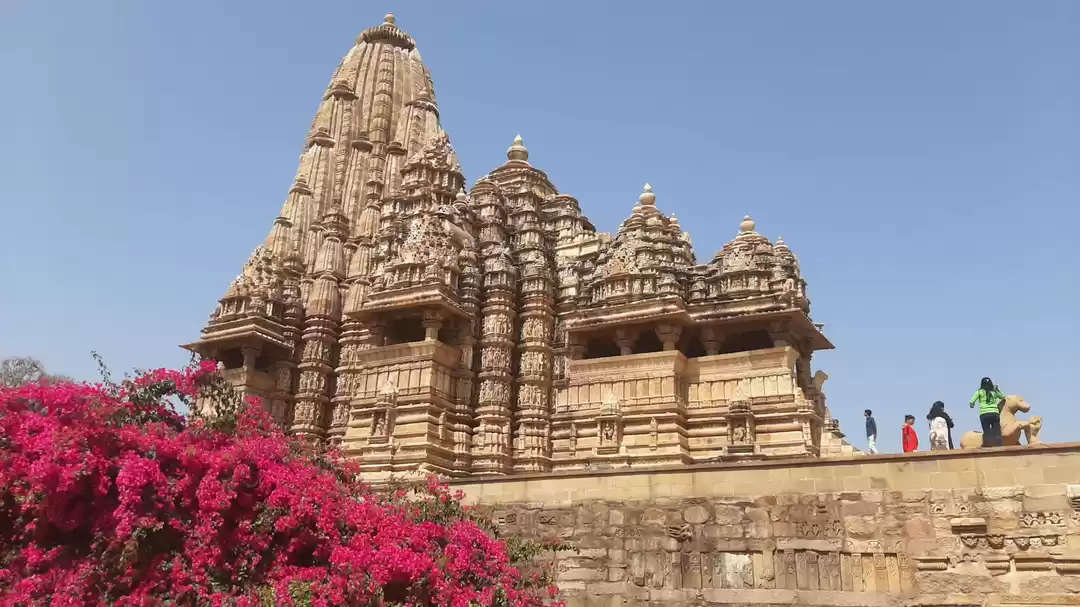
The corona virus was in the air. At New Delhi airport Lakshmi and I encountered a sea of green masks. The Air India flight had a brief stopover at Varanasi. Decent food, plenty of space, and only women on the Varanasi-Khajuraho sector excepting a lone male tour leader who was escorting a boisterous and friendly group of women Rotarians. We took a cab from the airport to the Ramada hotel. We liked the cabbie, so we hired him for the next three days. He turned out to be a godsend.

The Khajuraho temples, built by the Chandela rulers between 900 and 1130 CE, are among the most beautiful monuments in the country. The Chandelas established their political capital at Mahoba near Khajuraho sometime in the tenth century. Located in Chhatarpur District, Madhya Pradesh, the magnificent architectural creations represent an exotic blend of erotica and spirituality. The ASI plaque informs us that the region was known as Vatsa in ancient times, Jejakbhukti in the medieval era, and Bundelkhand from the fourteen century. The place apparently had 85 temples in its heyday, but only 22 seem to have survived the ravages of time.
From the 14th century onwards Khajuraho lapsed into oblivion and was rediscovered by a British engineer in 1838, when a palkiwala (palanquin-bearer) mentioned to him that the region had many temples with interesting architecture. By the time the restoration began in the 20th century, 70% of the structures had perished. There were Buddhist temples too, but only a few Hindu and Jain temples have survived. Of these, six are dedicated to Shiva, one to Ganesha, eight to Vishnu and his avatars, one to Surya, and three to Jain Tirthankars. The Chausath Yogini is said to have been a Durga temple and pre-dates the Chandela period. So does the Brahma temple.
All the temples are built in the nagara style with graded spires mimicking the rising peaks of the Himalayas, where the mythical Mt. Kailas, the abode of the gods is situated. Sandstone was used in the construction. However, the older temples - Chausath Yogini, Brahma and Lalgun Mahadev - are made of granite. Most the temples were built during the reign of Yashovarman and Dhangadev. Today Khajuraho is the subject of much speculation and hype. The presence of a wide array of erotic images continues to mystify history buffs.
Mysteries Galore
Everything about the Chandela Rajputs is mysterious. Their origin is obscure too. The Sound and Light Show gives us a mythical story about the Moon God being attracted to a pool-bathing damsel and descending to Earth to cavort with her, resulting in the inevitable divine conception. When day dawns the moon disappears, the dishonoured maiden comes to Khajuraho to give birth, a son Chandravarman is born, and lo and behold he somehow becomes the first Chandela! But as one of our guides told us the region still has beautiful damsels but the Moon God remains elusive. In any case the Chandelas considered themselves ‘Chandra-vanshi’ or descendants of the moon, like the Pandavas and Kauravas of the Mahabharata and unlike Lord Ram (who was a ‘Surya-vanshi’ or descendant of the Sun God).
Khajuraho was once enclosed by a wall with eight gates, each gate being flanked by two date palms. As ‘khajur’ means ‘date’ and ‘vahika’ means ‘bearing’, the name Khajur-vahika or Khajuraho meant date-bearing. ‘Khajur’ also means ‘scorpion’, thus we have another version of the name that means ‘scorpion-bearing’. The scorpion is associated with passion, and many of the female figures in the temples have scorpions etched on their thighs. This is mysterious too.

The explanations for the presence of erotica are many and varied. Some say the gratification of the senses is the pathway to the divine, that true spirituality can be attained when one learns to indulge in worldly pleasures and thereafter reach higher realms of consciousness. But there are more questions than answers.
Did the master sculptors, architects and kings subscribe to tantric beliefs? Did they intend to make the temples totally unique? Did they pick a bare-all strategy knowing full well that no other builders would do the same? Were they shameless hedonists unmindful of finer sensibilities? We simply don’t know. But the fact remains that erotic scenes form only a small part of the total carvings. There are many scenes from daily life, like a woman breast-feeding her child, women applying makeup, musicians and dancers, men going to battle, elephants, horses, apsaras, gods and goddesses.

It must be remembered that erotic art is not exclusive to Khajuraho. The Sun Temple at Konark in Odisha, the Bhand Deva temple in Rajasthan (also known as Little Khajuraho), as well as temples in Karnataka, Andhra, Gujarat, and even Nepal have amorous images.
Historical Facts
The Chandelas probably started out as vassals of the Pratiharas. Yashovarman (925-950 CE) became more or less independent, conquered the Kalinjar fortress, and commissioned the Lakshmana temple, but continued to acknowledge the superiority of the Pratiharas. His successor Dhangadev ruled from 950 CE to 999 CE as an independent king. His numerous inscriptions do not mention any overlord. The Viswanatha temple was commissioned by him towards the end of his reign.
Ganda and Vidyadhara were the subsequent rulers. It appears that Vidyadhara killed the King of Kannauj for failing to resist the invasion of Mahmud of Ghazni. Three years later Mahmud invaded Vidyadhara's kingdom, but he withdrew for reasons unknown. Perhaps Vidyadhara averted disaster by offering generous gifts. It seems he commissioned the Kandariya Mahadeva Temple in a spirit of thanksgiving for the exit of the dreaded invader.
Prithviraj Chauhan invaded the Chandela kingdom around 1182-1183 CE. The Muslim governor of Delhi invaded the kingdom around 1202-1203 CE. The kingdom appears to have been subdued, and gradually fell into decline.
Khajuraho was first mentioned by Al Beruni in 1022. (He accompanied Mahmud of Ghazni who attacked the nearby fortress of Kalinjhar in that year.) The Moroccan traveller Ibn Battuta visited this location some three centuries later and mentioned that Muslims had defaced the idols. By that time India had come under Muslim rule.
The fate of Khajuraho was sealed for centuries. But today tourists from all over the globe come here to marvel at the beautiful sculptures.
Darshan at Matangesvara Temple
This temple built around 1000 CE is adjacent to the Western temple complex. It lies outside the walled enclosure right next to the Lakshmana temple. We went there for a morning darshan. Plenty of women devotees thronged the temple at sunrise.

The saffron flag atop the temple proclaims that it is a living temple where puja is performed daily. It is the only one of the Khajuraho temples enjoying this status. We climbed the steep steps to the sanctum sanctorum where a larger-than-life lingam rose to the ceiling. A four feet high trident appears by the side of the lingam, obviously a recent addition.

I drank the theertham offered by the pujari and couldn’t help remembering the corona virus. I wondered whether I should just have patted the liquid over the top of my head.
THE WESTERN GROUP OF TEMPLES
The Western Group is within a neat enclosure and is meticulously preserved and maintained by the ASI. Gun-toting guards were everywhere. We asked one of them why he carried the gun. He said his job was to make sure no one damaged the temple. Too little, too late? I asked how come Aurangzeb didn’t destroy the erotic sculptures, but no one had an answer, least of all the ASI approved guide, who just blurted out some textbook stuff and added his own dose of salt, pepper and masala.
Signs of wanton destruction can be seen in all the temples, besides weathering and wear and tear. After all a thousand years is not a short duration.
A figure of a lion (presumed to be the emblem of the Chandelas) grappling with a kneeling figure appears at various places.
Lakshmana Temple
Opposite the Lakshmana Temple are two small shrines, one dedicated to Lakshmi and the other to Varaha. The Devi mandap is modest but the Varaha pavilion, built in 950 CE has a spectacular stone idol that glows like burnished metal. The intricate carvings are a delight to behold.

Built by Yashovarman between 930 AD and 954 AD, the Lakshmana Temple faces east and has little to do with Lakshmana. It is dedicated to Vishnu and has sculptures of the avatars, as well as an image of Lakshmi flanked by Brahma and Shiva. Inside the sanctum sanctorum a four armed, three headed Vishnu stands tall, with a lion head and a boar head besides a human face. The outer walls have Ganesha in standing pose (dancing?), many erotic sculptures and a variety of spectacular carvings.

Kandariya Mahadev Temple
Built in the reign of King Vidaydhara in 1029 CE the Kandariya Mahadev temple is a masterpiece of Chandela architecture. With 84 shikaras and 800 exquisite sculptures it is the largest and most magnificent temple in Khajuraho. The main shikara rises to a height of 116 feet.





Jagadambi Temple
A modest structure built in 1023 CE, the Devi Jagadambi temple has sculptures of Vishnu, Shiva, Brahma, Varaha and Bhumidevi, not to mention the 8 dikpalas. And there are the inevitable maidens, amorous couples and what not. It is in fact a Kali temple which may have been dedicated to Vishnu at the outset.

Chitragupta Temple
Built between 1000 and 1025 CE, this is similar in appearance to the Jagadambi temple and has an image of Suryadev riding a chariot with seven horses. The outer wall has an image of Vishnu with eleven heads, besides the buxom beauties with languid poses, the erotic couples, et al.
Viswanath Temple
The Viswanath Temple is dedicated to Lord Shiva and is one of the finest examples of Chandela architecture. The inscription says it was built by Dhanga in 1002 CE, and refers to the dedication of two lingas, one in emerald and the other in stone. Today, quite predictably, only the stone linga remains. At the bottom of the steps leading to the temple there is an interesting sculpture of an elephant poised to trample a man, while the rider covers his face with his hand. Facing the Vishwanath temple is a small Nandi pavilion, where the massive image of the sacred bull has a metallic lustre.




A shrine to Parvathi seems to be a part of this complex. However there are distinct images indicating that the shrine was originally dedicated to Vishnu. Apart from a resplendent image of Uma in the sanctum sanctorum, the lintel shows a four armed Vishnu seated on Garuda.
SOUTHERN (or South-eastern) GROUP OF TEMPLES
Duladeo Temple
This temple was probably built around 1125 CE and was severely damaged. The reconstruction is far from perfect and the defects are obvious. However, the dancing damsels on the pillars are noteworthy. It is dedicated to Shiva, the bridegroom, and is probably the last of the temples built by the Chandelas.

Chaturbhuj Temple
We went there at sunset. The temple faces west (or south-west) and the rays of the setting sun dramatically illuminate the idol. It has an impressive ornamental doorway. Some say the idol is of Harihara, a combination of the two major Hindu deities, Shiva and Vishnu. The image is carved out of a single stone.




The Sanskrit name "Chaturbhuj' means one with four arms and refers to Vishnu. The temple is modest and dated to 1110 CE. It’s the only temple in Khajuraho without erotic sculptures. It is located near the Jatakara village and hence it is sometimes referred to as the Jatakari Temple.
EASTERN GROUP OF TEMPLES
The group comprises three temples, viz. Brahma, Javari and Vamana.
The Brahma Temple is a small structure in a state of disuse. Dated to 925 CE it predates the Chandela dynasty. No sign of any idol, no puja, no visitors. No gun-toting guards like in the other temples.

The Javari Temple, built between 1075 and 1100 CE, is a look-alike of the Chaturbhuja temple. The makarathorana is exquisite. However, many of the sculptures on the outer wall have suffered extensive damage.
The Vamana Temple is dedicated to the 5th avatar of Vishnu. It was probably built between 1050 and 1075 CE. Like all other temples in Khajuraho, this one too is built on a raised platform. The outer walls have two bands of sculptures and one can see Narasimha (Avatar No.4), Varaha (Avatar No. 3) and Mahavishnu himself, besides a whole lot of beautiful nymphs. Inside the temple the idol of Vamana, the dwarf avatar, has partially damaged arms, and is flanked by Ganga and Yamuna. There are a few amorous couples skilfully carved in the doorway. In fact the carvings are intricately done and present an impressive facade.



The temple has suffered extensive damage and the restoration effort leaves much to be desired, yet the overall effect leaves you spellbound.
JAIN TEMPLES
A woman playfully tugs at a man’s beard. Another removes a thorn from her foot. A mother breast-feeds an infant. These are among the myriad images on display at the Jain temples. Buxom belles are all over the walls. The erotic is interspersed with the chores of daily life but the overall aura is one of joy and celebration, sometimes uninhibited, even perverse, yet in the final analysis, deeply spiritual.
The Jain sculptures are no less erotic than the Hindu images. In fact the temples of Khajuraho all share many similarities, and resemble the temples of Odisha in overall appearance. There are three main Jain temples - the Parshvanath and Adinath temples built in the Middle Ages, and the more recent Shantinath temple.


The Parshvanath Temple, built around 954 CE, has some of the most elegant sculptures of Khajuraho and is reasonably well preserved. Figures of a host of Hindu deities adorn the walls - Lakshmi- Vishnu, Kamadev-Rati, Ram-Sita and Hanuman. We also find the ashta-dikpalas or guardians of eight directions (viz. Indra, Agni, Yama, Kubera, Varuna, Vayu, Nirrti, and Isana). This temple also has exquisite sculptures of nubile nymphs in languid poses.

The Adinath Temple was built around 1027 CE and bears some resemblance to the Vamana Temple. The Shantinath Temple boasts a 14 feet idol of the 16th Jain tirthankar installed in 1028 CE. Legend has it that about 400 years ago, when invaders tried to break down the little finger of the idol with a hammer, milk came gushing out of the ‘wound’ and simultaneously a swarm of bees descended upon the infidels, who fled in disarray. This is the Atishay (miracle) kshethra. The present temple is built up of damaged pieces salvaged from all the other temples, perhaps 14 in number. It is an important pilgrimage site for Digambar Jains. The complex has a dharamshala for visiting devotees.



Chausath Yogini – An Enduring Mystery
We visited the chausath yogini temple at sunset. Our cab driver Ramu seemed surprised when we said we wanted to go there. Dated to 885 CE, this ancient temple dedicated to the goddess Durga and 64 yoginis, is all of a ruin. There are hardly any idols, but there are dozens of small alcoves on a raised platform, and telltale signs of basic worship. Nobody seemed to know who the yoginis were and what they had to do with Durga. It appears that for centuries after the fall of the Chandelas and their successors, Khajuraho was peopled only by yogis. Perhaps there were yoginis too.


Madhya Pradesh has two other chausath yogini temples at Mitaoli and Jabalpur. The Jabalpur temple suffered extensive damage at the hands of Aurangzeb’s army. Odisha has chausath yogini temples at Ranipur and Hirapur. All these temples, with the exception of the Khajuraho shrine, have a circular design. It is rumoured that the circular shrine of Mitaoli inspired the British architects who designed the Indian Parliament building.
Did these temples have something to do with tantric beliefs and rituals? Did they represent the 64 arts mentioned in the Kamasutra? That they certainly celebrated the feminine there is no doubt. But our Sanskrit texts offer few clues. Other than Durga and Kali riding out to do battle accompanied by armies of female warriors, we know pretty little about the yoginis. Were they attendants, devotees or warriors? Were they courtesans? The mystery endures.
The temples were abandoned centuries ago for mysterious reasons and rediscovered only in the last century. Did the feminine deities gradually lose favour as Shaivism and Vaishnavism rose to prominence? Did the arrival of celibate yogis overshadow the yoginis who celebrated life in all its colours? Did Buddhism and Jainism have a role to play in the disappearance of the devis? Did the Muslim conquests make such worship impossible? We can only speculate. Today there are new deities in Durga’s place, such as Shiva and Parvati riding a Nandi at Jabalpur, and a traditional shivaling at Mitaoli.
Raneh Waterfall
20 kilometers east of Khajuraho, the Raneh Falls are the region’s version of the Grand Canyon. Located within the Panna National Park the area is carefully nurtured by the Forest department. The canyon is 5 km long and 100 feet deep. The road passes through a wooded area and leads us to the rocky canyon of the Ken River (Karnavati was the original name! It's high time we reverted back to the original! Ken sounds ridiculous.)
Amidst gigantic boulders the river plunges through many deep gorges. The rocks are of five different colours. Our driver told us there was a volcanic eruption once upon a time so there is solidified lava as well.


This is a pleasant spot for trekking. Not to worry because the forest guides will accompany you and the hordes of langurs will keep their distance. Feeding is strictly forbidden and obviously you can’t eat anything. We saw peacocks, nilgai, spotted deer and wild boar.
We gave the Panna Tiger Reserve a miss, and learnt later that the Rotarian ladies, who had accompanied us on the flight from Delhi, had spent a night at the Tendu Leaf Resort and gone on a tiger safari but had failed to spot even a single tiger.
General Tips
Ramu, our cab driver, was polite, soft-spoken, respectful, and always on time. The vehicle was very well maintained. Ramu’s number is 95891 34719. If you plan to visit Khajuraho, I suggest you call him.
You don’t need a travel agency or tour operator even if you plan to travel solo. Book your flight, book a decent hotel and you are all set. Call Ramu and he will take you wherever you wish to go. If you don’t have a clue, he will guide you.
Go for the dances and the museums. The local artists need your applause. Buy yourself a bamboo dupatta. It looks like silk and is dirt cheap.
Eat out at the Pinch of Salt Restaurant and Badri Seth’s place. Savour guava chutney, Bundelkhandi chicken, and a whole lot of unusual dishes.

Whispered Tip: You don’t need ASI guides!




